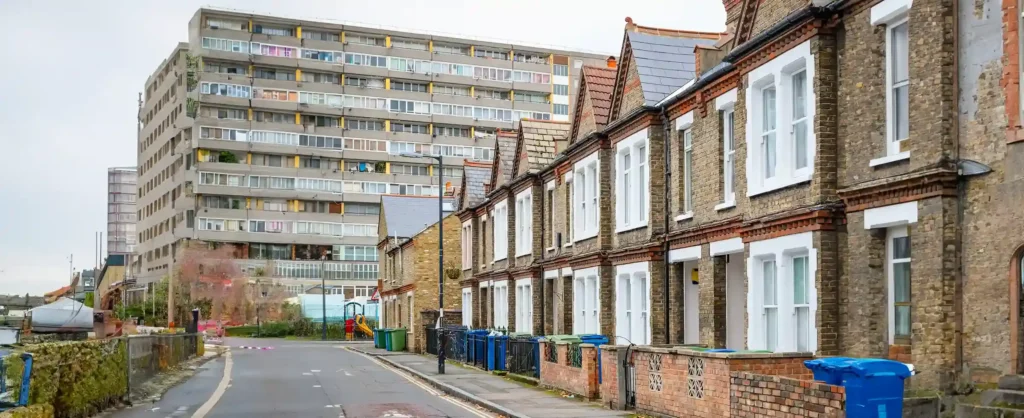For those unfortunate enough to deal with it this year, It should come as no surprise that England’s housing market is not in its best condition. What might be a bit more surprising is that a recent study by an international think tank has revealed that England currently has the worst housing market in the developed world.
Between inflated mortgage rates, shifting house prices and a rising cost of living, it has arguably never been more difficult to find reliable, affordable housing for tenants, homebuyers and investors alike. And, according to forecasts from financial institutions like Lloyds Banking Group, 2024 may not see much of an overall improvement.
The bottom line is that England’s housing market needs fast change. But the details of what that change could be lies in understanding the problems currently plaguing our housing market.
Why Housing Needs to Change for Renters
As always, renters are arguably the most heavily impacted by housing market failures. This is especially true in the case of private rented housing, where they tend to shoulder the costs of mortgage rate hikes and economic downturns for their landlords. In fact, a recent article from the Guardian suggests that average private home rents recently reached their highest point on record at £1,278 per month outside of London and £2,627 a month within it.
Whereas the private rented sector is largely at the mercy of individuals and the economy, social housing is usually intended to remain a consistently available safe port for the most vulnerable renters in the housing market. This is arguably where England is failing renters most, especially with the recent uptick in no-fault evictions following delays to the Renters Reform Bill.
If you read our CCG blog on the problems affecting temporary accommodation, you might recall that the system is being overburdened by excessive demand and extreme cost. With the Independent recently reporting that the number of families living in temporary accommodation has hit a record high of 105,750 households, a rise of 89% since 2013, it may not come as a surprise to know that the Local Government Association (LGA) reported that councils are spending a combined total of £1.74 billion last year to prop up their temporary accommodation.
The widely reported deficit in social housebuilding is a significant factor in the overreliance on temporary accommodation and the biggest culprit behind the mounting housing affordability and availability issues keeping the market dire for renters. Earlier this year, a shocking report revealed that most local councils in England had yet to build even a single social home since 2023 started, falling measurably short of the nation’s new home targets.
In short, any overarching economic issues facing England’s housing market are being amplified by the worsening condition of the safety net social housing is meant to represent.
For renters, more affordable and social housing is a must. But, with demand for quality housing soaring to the point that the average queue of tenants requesting even to view a rental property has risen from six in 2019 to 25 this year and a 5% increase in rent forecast for 2024 by Zoopla, it seems increasingly unlikely that the country will be capable of clearing its housing shortfall and keeping pace with rental housing demand at its current housebuilding rate, especially since accomplishing the former alone is projected to take approximately 25 years even at an inflated rate of 442,000 homes annually.
Why Housing Needs to Change for Homebuyers, Homeowners and Landlords
Were the current state of mortgage rates not inventive enough to avoid major property purchases this year, a recent report by the Home Builders Federation (HBF) has exposed several vulnerabilities and shortcomings in the UK’s housing market that illustrate its poor condition compared to similar developed nations while putting would-be homeowners, homebuyers and landlords in the economic crosshairs. These include:
- House prices increasing faster than income, to a greater degree in the UK than in other European nations.
- England hosting the largest number of people living in households that spend more than 40% of their income on housing in Europe at 11.3 million.
- England possessing fewer dwellings relative to its population than most similar developed nations like France and Italy.
- The UK possessing some of the oldest housing in Europe, with 15% failing to meet the Decent Homes Standard in 2020 – the highest proportion of substandard homes in Europe.
- Homeownership falling by 17% leading up to 2021, despite growing over the same period in countries like Italy and the Netherlands showing growth over the same period.
This data, combined with forecasts suggesting that house prices may continue to fall throughout 2024 with no chance of recovery until 2025 at the latest, risk undermining the once reliable foundation of buy-to-let property investment for landlords while increasing the costs and depleting the supply of housing for homeowners and homebuyers.
Furthermore, increased scrutiny is being placed on the overall quality of private rented housing due to previously mentioned developments like the Decent Homes Standard and the Renters Reform Bill. While this can only be a good thing for most, landlords may struggle with the costs associated with meeting more stringent quality and energy efficiency standards in a market already threatened by excessive mortgage rates and mass market exoduses by dissatisfied landlords.
Reinforcing the dip in affordability even for those in ownership of their properties is a recent article from the Guardian that highlighted the growing disparity between the wealth of the average US household and their UK counterparts, which can be largely attributed to the UK’s more expensive housing and lower standard of living.
How Property Investors Can Stay Secure
The hostility of the UK housing market makes it an unsettling prospect for would-be property investors in the current economic climate. Mortgage rates are set to remain above the golden 2% for the foreseeable future and house prices are just as likely to stay high, if not more likely.
For an affordable, risk-averse solution for investing in buy-to-let property with fixed passive income, we offer a one-of-a-kind property investment opportunity that is mortgage-free, fully managed and, above all, affordable.
While the housing market itself still has a ways to go before it reaches a point where it no longer falls so drastically short of similar countries, everyday investors can still forge paths to financial security through alternative methods of property investment.
To find out more about investing in property without wrestling with our current housing market, contact our team today.













